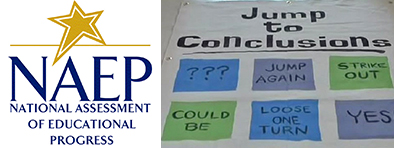Delaware’s NAEP Results: Draw Your Own Conclusion
A few days ago we published a blog on Delaware’s NAEP Results: 5 Data Takeaways. Here are some data considerations to keep in mind as you read the tea leaves from this year’s NAEP results.
1. Lookout for misNAEPery—the misuse of NAEP data. National bloggers like Mike Petrilli are warning against jumping to conclusions about the policy implications of 2015 NAEP results (correlation is not causation!), and education researcher Morgan Polikoff’s blog, Friends don’t let friends misuse NAEP data, points out some examples of misNAEPery to avoid.
2. Avoid comparing apples and oranges—NAEP and the statewide Smarter assessment measure different things. The NAEP is administered to a sampling of fourth graders and eighth graders, in each state, every two-years. While NAEP draws upon similar approaches and ideas as assessments of the Common Core, it is not wholly aligned to the Common Core. In contrast, the statewide Smarter assessment is administered annually to students in grades three to eight and 11. Unlike the NAEP, the Smarter assessment is aligned with the Common Core and provides student-level data.
3. Consider more than just test scores for a holistic picture of student success. NAEP is one of the few robust, nationally comparable, long-term measures of student learning available. However, other measures of student success, like high school graduation rates, also contribute to the full picture. Check out this Vision Coalition infographic summing up progress among some of these other indicators, or other data resources.
4. Explore the data yourself. There are several resources you can explore for more information on Delaware’s NAEP results, including: the main NAEP website (for general findings), and the National Center for Education Statistics (for more statistics, graphs, and one-pager reports).
Related Topics: assessments, Delaware, NAEP, testing

